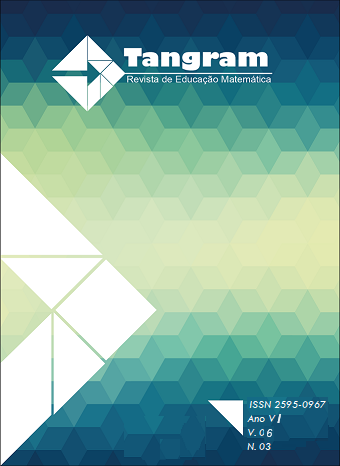The Geometry of Origami: exploring Haga’s Theorem in a knowledge mobilization course
DOI:
https://doi.org/10.30612/tangram.v6i3.17147Keywords:
Folding, mathematical proofs, Mathematics EducationAbstract
In this article we present the results of a research with the objective of investigating the mathematical knowledge developed by students of the university extension course “Mathematics, Origami and Production of Digital Videos”. Initially, we explain aspects of qualitative research, describe the research scenario and present some fundamentals about origami geometry, highlighting its basic operations. In terms of results, we discussed how the participants explored Haga's Theorem and highlighted the importance of creases in the paper for the movement of argumentation and discussion about mathematical proofs. We also mentioned aspects of thinking-with-media in the face of participants' interactions with GeoGebra software and origamis. The research contributes to the production of knowledge in Mathematics Education involving the themes of origami, arts, mathematical proof and digital technologies.
Downloads
References
Batistela, R. F., BarbarizA, T. A. M. & Lazari, H. (2016). Um estudo sobre demonstrações matemática por/com computador. Revista Eletrônica de Educação Matemática – REVEMAT, 11(1), 204- 215.
Bicudo, M. A. V. (1993). Pesquisa em educação matemática. Pro-Posições. 4(1), 18-23.
Borba, M. C. & Villarreal, M. E. (2005). Humans-With-Media and the Reorganization of Mathematical Thinking: information and communication technologies, modeling, experimentation and visualization. New York: Springer,..
Borba, M. C. (2021). The future of mathematics education since COVID-19: humans-with-media or humans-with-non-living-things. Educational Studies in Mathematics, 108, 385-400.
Chizzotti, A. (2003). A pesquisa qualitativa em ciências humanas e sociais: evoluções e desafios. Revista Portuguesa de Educação, 16(2), 221–236.
Demaine, E. D. & O'Rourke, J. (2007). Geometric folding algorithms: linkages, origami, polyhedra. New York: Cambridge University Press, 472p.
De Villiers, M. (2001). Papel e Funções da demonstração no trabalho com o Sketchpad. Educação e Matemática, 1(62), 31 – 36.
Doering, L. R., Ripoll, C. C. & Silva, E. V. M. (2022). Construções e percepções de alguns alunos de licenciatura em matemática sobre demonstrações. Revista Eletrônica de Educação Matemática – REVEMAT, 17, 01 – 22.
Faria, R. C. W. S., Romanello, L. A. & Domingues, N. S. (2018). Fases das tecnologias digitais na exploração matemática em sala de aula: das calculadoras gráficas aos celulares inteligentes. Amazônia: Revista de Educação em Ciências e Matemáticas. 14(30), 105-122.
Gróla, M. G., & Gualandi, J. H. (2023). O ensino de geometria e o desenvolvimento do pensamento geométrico: um mapeamento de pesquisas realizadas no estado do Espírito Santo. TANGRAM - Revista De Educação Matemática, 6(1), 63–99. https://doi.org/10.30612/tangram.v6i1.16883
Haga, K. (2008). Origamics: mathematical explorations through paper folding. Singapore: World Scientific. 134p.
Hull, T. C. (2013). Project Origami: Activities for Exploring Mathematics. 2 ed. New York: CRC Press. 338p.
Hull, T. C. (2021). Origametry: Mathematical Methods in Paper Folding. New York: Cambridge University Press. 332p.
Lang, R. J. (1996). A computational algorithm for origami design. In: Proceedings annual symposium on computational geometry, 96, Pleasanton. ACM, 98-105.
Lourenço, M. L. (2002). A Demonstração com Informática Aplicada à Educação. Bolema. 15(18), sem paginação.
Lucero, J. C. (2019) Existence of a Solution for Beloch’s Fold. Mathematics Magazine, 92(1), 24-31.
Mazzi, L. C. (2018). As demonstrações matemáticas presentificadas nos livros didáticos do ensino médio: um foco nos capítulos de Geometria. 160 f. Tese (Doutorado em Ensino de Ciências e Matemática) - Instituto de Física, Universidade Estadual de Campinas, Campinas.
Monteiro, L. C. N. (2008) Orígamí: história de um geometría axíomátíca. 111 f. Tese (Mestrado em Matemática para o Ensino) – Departamento de Matemática, Universidade de Lisboa, Lisboa, 2008.
Pope, S. & Lam, T. K. (2011). Origami and Learning Mathematics. In: Iverson, P. W.; Lang, R. J.& Yim, M. Origami 5: Fifth international meeting of origami science, mathematics and education (5OSME). New York: CRC Press. 205 – 217.
Santa, Z. M. R. (2016). Producción de conocimiento geométrico escolar en un colectivo de professores-con-doblado-de-papel. 389 f. Tese (Doutorado em Educação) – Faculdade de Educação, Universidad de Antioquia, Antioquia, 2016.
Downloads
Published
How to Cite
Issue
Section
License

This work is licensed under a Creative Commons Attribution-NonCommercial-ShareAlike 3.0 Unported License.
Authors must accept the publication rules when submitting the journal, as well as agree to the following terms:
(a) The Editorial Board reserves the right to make changes to the Portuguese language in the originals to maintain the cultured standard of the language, while respecting the style of the authors.
(b) Authors retain the copyright and grant the journal the right to first publication, with the work simultaneously licensed under the Attribution-NonCommercial-ShareAlike 3.0 Brazil (CC BY-NC-SA 3.0 BR) that allows: Share - copy and redistribute the material in any medium or format and Adapt - remix, transform, and create from the material. CC BY-NC-SA 3.0 BR considers the following terms:
- Attribution - You must give the appropriate credit, provide a link to the license and indicate whether changes have been made. You must do so under any reasonable circumstances, but in no way that would suggest that the licensor supports you or your use.
- NonCommercial - You may not use the material for commercial purposes.
- Sharing - If you remix, transform, or create from material, you must distribute your contributions under the same license as the original.
- No additional restrictions - You may not apply legal terms or technological measures that legally restrict others from doing anything that the license permits.
(c) After publication, authors are allowed and encouraged to publish and distribute their work online - in institutional repositories, personal page, social network or other scientific dissemination sites, as long as the publication is not for commercial purposes.






